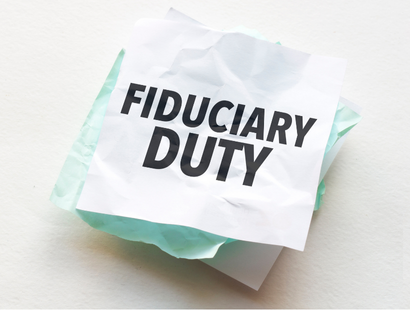
In 2015, Mike Carney stated:
“Climate change is the Tragedy of the Horizon,” and warned that ignoring it could breach fiduciary obligations.
At the 2025 RIAA Conference, Paul Clements-Hunt reinforced and advanced that view with a statement every investment committee, trustee boardroom, and legal department should now regard as foundational:
“Climate risk is now fiduciary duty.”
This shift isn’t just rhetorical. It reflects a systemic transformation in how financial, legal, and governance frameworks interpret what it means to act in the best interests of beneficiaries. A decade ago, fiduciary responsibility was commonly seen as synonymous with maximising financial returns. Today, it’s also about how those returns are earned, and whether the risk-adjusted pathway aligns with long-term resilience and systemic risk mitigation.
Nowhere is this shift more urgent, or more measurable, than in the integration of climate risk. This article examines why climate risk is now widely recognised as a fiduciary issue and what investors must do to align their due diligence processes with this evolving standard.

What is climate risk? Two dimensions, one obligation
Climate risk is typically categorised in two forms: transition risk and physical risk.
Transition risk refers to the financial threats and uncertainties that arise as economies shift toward net-zero emissions. This includes exposure to carbon pricing, emissions disclosure regulation, policy misalignment, reputational liability, technological disruption, and changing market preferences.
Physical risk, by contrast, encompasses the chronic and acute environmental effects of climate change, rising sea levels, increased wildfire frequency, extreme heat, and water scarcity, which can affect company operations, supply chains, asset values, and insurance premiums.
These risks are no longer hypothetical. They are measurable, material, and increasingly priced by markets, albeit inefficiently.
Transition risk: material, mispriced, and growing
Transition risk captures the economic and financial uncertainty that arises as companies, sectors, and economies shift toward net-zero emissions. It is one of the most pressing and misunderstood investment challenges of the decade.
This form of risk comes in many shapes – carbon pricing, emissions regulation, green subsidies, capital reallocation, reputational shifts, or even consumer preferences moving faster than supply chains. While these trends may drive opportunity for some, they represent direct cost and disruption for others.
Importantly, transition risks are not theoretical. A 2024 global study by Li, Luo, and Tang found that firms exposed to climate regulation suffered a 3.57% drop in market value per standard deviation of regulatory risk. High-carbon firms were hit the hardest, especially in markets where policy action is accelerating. While the downside impact of regulatory transition is increasingly priced, climate-related upside, such as technological adaptation or market leadership in low-carbon segments, remains undervalued, skewing the opportunity-risk balance [1].
Cepni et al. (2024) further quantified the effect, finding that transition risk leads to a 5.6% increase in the cost of equity, especially for firms lagging in climate readiness. This reflects investor concerns about their ability to manage decarbonisation [2].
Performance analysis from Reboredo and Ugolini (2022) shows that firms with the lowest transition risk exposure consistently outperform high-risk peers across return on assets, return on equity, and stock market performance. These gaps are particularly strong in jurisdictions with mature policy environments, such as the EU post-COP21, demonstrating that regulatory momentum directly impacts financial outcomes [3].
Carbon pricing mechanisms and transition-related regulation not only affect valuation; they also impact profitability. This impact differs across climate scenarios. In 2°C-aligned scenarios with moderate pricing, companies may experience manageable margin pressures. But in delayed-action or 4°C scenarios, sudden and severe regulation can significantly erode profitability for carbon-intensive firms.
These findings confirm that transition risks, especially regulatory changes, materially lower firm value, while the benefits of climate opportunity remain under-appreciated. The authors call for improved risk disclosure, better analytics, and more consistent policy frameworks to support balanced valuation.
For fiduciaries, the message is clear: transition risk is financially material, unevenly distributed, and increasingly priced. Due diligence must adapt accordingly.
Fiduciary duty reframed: legal clarity and global consensus
Fiduciary duty has expanded in scope. No longer limited to short-term financial maximisation, it now explicitly includes systemic risk oversight, sustainability impact alignment, and long-term value creation.
The UN PRI and UNEP FI’s Fiduciary Duty in the 21st Century report put it plainly:
“Investors who fail to incorporate ESG issues are failing their fiduciary duties and are increasingly likely to be subject to legal challenges.”[4]
The Freshfields Legal Framework for Impact further reinforced that climate and ESG risks are not optional considerations; they are expected elements of prudent decision-making:
“Fiduciary duties do not preclude pursuing sustainability impact goals; indeed, they may require it where financially material.”[5]
This alignment is reflected in Australian regulatory guidance too, with APRA and ASIC stating:
“Failure to consider long-term investment value drivers, which include ESG issues, is itself a failure of fiduciary duty.”[6]
In short, the law is catching up with the data. Sustainable, responsible investment and fiduciary duty are not only compatible, they are increasingly interdependent.[7]
Physical risk: real, but often underweighted
While transition risk is gaining traction in markets and policy frameworks, physical risk remains harder to quantify. Yet both chronic and acute physical risks are financially material and must be considered in investment decisions. [8]
Research by Reboredo and Ugolini (2022) shows that acute physical events, though impactful at the firm level, are often underpriced relative to their economic disruption. And while direct asset damage tends to be geographically concentrated and diversifiable, system-wide risks such as supply chain breakdowns, margin erosion, and insurance repricing may carry broader implications.
Many investors continue to rely on static, aggregate data – Scope 1 & 2 emissions, country-level GDP exposure – without considering asset-level or geospatial vulnerability. The International Corporate Governance Network (ICGN) warns:
“Climate change has emerged as one of the most pressing ‘higher order’ systemic financial risks… resulting in property damage, insurance write-downs, and interruptions of global business operations.”[9]
Tools like Emmi’s Carbon Diagnostics platform help close this gap by enabling firm-level and portfolio-wide market-based physical risk assessments that consider asset type, country and sector exposure – data points that traditional risk models may lack.
Importantly, while individual firms or assets can face significant losses from floods or wildfires, diversified portfolios often absorb these shocks with minimal long-term performance impact. As such, the investment relevance of physical risk is more likely to emerge through supply chain vulnerabilities, sectoral cost shifts, and long-term margin pressures, not direct asset damage alone.
In this context, aligning physical risk assessment with proportional, sector-based, and forward-looking analysis may offer investors a more practical path. Recent approaches, including those using statistical stress testing or scenario-based probabilistic models, show promise in bridging the gap between climate science and investment decision-making without overextending on granularity.
Our research shows that the choice of modelling method can materially shift risk exposure and outcomes. For a more apparent connection between emissions, financial value, and portfolio strategy, Emmi’s ML model offers a trusted and scalable solution.
Why this matters: litigation, legislation, and reputation
The consequences for inaction are no longer theoretical. In 2023, more than 2,000 climate-related legal cases were filed globally. Regulatory regimes are tightening too: CSRD and SFDR in the EU, ISSB-aligned reporting in the UK and across Asia, and mandatory climate disclosure rolling out in Australia.
Litigation risk, regulatory enforcement, and reputational exposure are converging with traditional financial risk, and better ESG practices significantly reduce ex ante expectations of a left-tail event. [10]
Given this convergence of risks, investors are increasingly asking: What does a prudent, climate-aware investment response look like in practice?
Regional distribution of policy interventions

The financial case for rebalancing
Evidence continues to mount that ESG integration reduces downside risk and preserves diversification in most cases, without a material sacrifice in return. [11]
A 2022 study by Bressan et al. showed that institutional portfolios could reduce transition risk exposure by 10% without breaching market neutrality, with yield impacts of less than 80bps [12]. ESG-screened portfolios, meanwhile, showed 0.16% higher average annual returns, better tail protection, and stable or improved diversification metrics [11].
In essence: climate-aligned investing is not a trade-off. It is a risk-mitigation tool that pays for itself.
From theory to practice: meeting the standard
Fiduciary-quality due diligence is:
- Evidence-based: Integrating ESG alongside financial analysis
- Scenario-driven: Including stress tests for both transition and physical shocks
- Transparent: With documentation and benchmarking aligned to legal and stewardship expectations
- Forward-looking: Using real data to assess resilience, not just emissions
Tools like Emmi offer the analytics to support this, from sector-based carbon exposure to scenario-aligned valuation impacts. Climate risk is investment risk, and increasingly, fiduciary risk.
The bottom line: this is a test
Climate risk is testing whether fiduciaries are prepared, responsive, and aligned with evolving standards. It is testing whether investment leaders will continue relying on outdated models or shift toward frameworks that integrate the risks and opportunities of a net-zero future.
Fiduciary duty is no longer just about generating alpha. It is about preserving trust, protecting capital, and managing exposure in a climate-constrained world.
So let’s ask again:
Are you holding up your end of the deal?
Explore our latest research to see how better carbon data supports better investment management.
Emmi’s proprietary machine-learning model provides financed emissions data and climate risk analysis across all major public and private asset classes.
Built on objective, complete, accurate, and timely data principles, Emmi’s methodology ensures that every data point is transparent and reusable.
Our tools also translate emissions into financial implications, based on climate and pricing scenarios. This gives our clients actionable insights about their carbon exposure.
References
- Li, Luo, & Tang (2024). Climate Risk and Opportunity Exposure and Firm Value: An International Investigation. https://doi.org/10.1002/bse.3747
- Cepni, Şensoy & Yılmaz (2024). Climate Change Exposure and Cost of Equity, Energy Economics. https://doi.org/10.1016/j.eneco.2023.107288
- Reboredo & Ugolini (2022). Climate Transition Risk, Profitability and Stock Prices, International Review of Financial Analysis. https://doi.org/10.1016/j.irfa.2022.102271
- UN PRI, UNEP FI, The Generation Foundation (2019). Fiduciary Duty in the 21st Century. https://www.unepfi.org/investment/history/fiduciary-duty/
- Freshfields Bruckhaus Deringer (2021). A Legal Framework for Impact. https://www.unpri.org/download?ac=21308
- NAB & ACFS (2017). A Review of Socially Responsible Investing in Australia. https://business.nab.com.au/wp-content/uploads/2017/06/socially-responsible-investing-in-australia.pdf
- Martin, W. (2009). Socially Responsible Investing: Is Your Fiduciary Duty at Risk?, Journal of Business Ethics. https://doi.org10.1007/s10551-009-0060-x
- UN PRI (2020). An Overview of Investor Duties. https://www.unpri.org/investor-duties/an-overview-of-investor-duties/6538.article
- ICGN (2018). Guidance on Investor Fiduciary Duties. https://www.icgn.org/sites/default/files/2021-06/ICGN%20Guidance%20on%20Investor%20Fiduciary%20Duties.pdf
- McCahery, Pudschedl & Steindl (2022). Institutional Investors, Alternative Asset Managers, and ESG Preferences. https://link.springer.com/article/10.1007/s40804-022-00264-0
- Verheyden, Eccles & Feiner (2016). ESG for All? The Impact of ESG Screening on Return, Risk, and Diversification, Journal of Applied Corporate Finance. https://doi.org/10.1111/jacf.12115
- Bressan, Monasterolo & Battiston (2022). Sustainable Investing and Climate Transition Risk, Journal of Portfolio Management. https://jpm.pm-research.com/content/48/10



